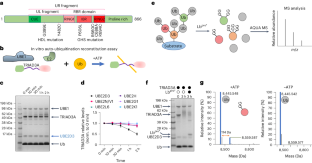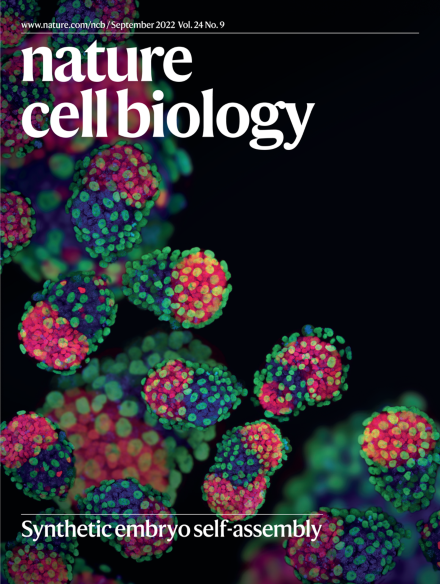The autophagy adaptor TRIAD3A promotes tau fibrillation by nested phase separation
IF 17.3
1区 生物学
Q1 CELL BIOLOGY
引用次数: 0
Abstract
Multiple neurodegenerative diseases are characterized by aberrant proteinaceous accumulations of tau. Here, we report a RING-in-between-RING-type E3 ligase, TRIAD3A, that functions as an autophagy adaptor for tau. TRIAD3A(RNF216) is an essential gene with mutations causing age-progressive neurodegeneration. Our studies reveal that TRIAD3A E3 ligase catalyses mixed K11/K63 polyubiquitin chains and self-assembles into liquid–liquid phase separated (LLPS) droplets. Tau is ubiquitinated and accumulates within TRIAD3A LLPS droplets and, via LC3 interacting regions, targets tau for autophagic degradation. Unexpectedly, tau sequestered within TRIAD3A droplets rapidly converts to fibrillar aggregates without the transitional liquid phase of tau. In vivo studies show that TRIAD3A decreases the accumulation of phosphorylated tau in a tauopathy mouse model, and a disease-associated mutation of TRIAD3A increases accumulation of phosphorylated tau, exacerbates gliosis and increases pathological tau spreading. In human Alzheimer disease brain, TRIAD3A co-localizes with tau amyloid in multiple histological forms, suggesting a role in tau proteostasis. TRIAD3A is an autophagic adaptor that utilizes E3 ligase and LLPS as a mechanism to capture cargo and appears especially relevant to neurodegenerative diseases. Zhou et al. show that the E3 ubiquitin ligase TRIAD3A assembles into liquid–liquid phase-separated droplets that contain tau and promote conversion to fibrillar aggregates and tau autophagic degradation.


自噬适配体TRIAD3A通过嵌套相分离促进tau纤维化
多种神经退行性疾病的特征是 tau 蛋白质的异常积累。在这里,我们报告了一种 RING-in-between-RING 型 E3 连接酶 TRIAD3A,它可作为 tau 的自噬适配体发挥作用。TRIAD3A(RNF216)是一个重要基因,其突变可导致年龄进行性神经退行性变。我们的研究发现,TRIAD3A E3连接酶能催化混合的K11/K63多泛素链,并自组装成液相-液相分离(LLPS)液滴。Tau被泛素化并聚集在TRIAD3A LLPS液滴中,并通过LC3相互作用区将tau作为自噬降解的靶标。意想不到的是,螯合在TRIAD3A液滴中的tau会迅速转化为纤维状聚集体,而不会出现tau的过渡液相。体内研究表明,TRIAD3A 可减少磷酸化 tau 在一种 tauopathy 小鼠模型中的积累,而与疾病相关的 TRIAD3A 基因突变会增加磷酸化 tau 的积累,加剧胶质病变并增加病理 tau 的扩散。在人类阿尔茨海默病大脑中,TRIAD3A以多种组织学形式与tau淀粉样蛋白共定位,表明其在tau蛋白稳态中发挥作用。TRIAD3A是一种自噬适配体,利用E3连接酶和LLPS作为捕获货物的机制,似乎与神经退行性疾病特别相关。
本文章由计算机程序翻译,如有差异,请以英文原文为准。
求助全文
约1分钟内获得全文
求助全文
来源期刊

Nature Cell Biology
生物-细胞生物学
CiteScore
28.40
自引率
0.90%
发文量
219
审稿时长
3 months
期刊介绍:
Nature Cell Biology, a prestigious journal, upholds a commitment to publishing papers of the highest quality across all areas of cell biology, with a particular focus on elucidating mechanisms underlying fundamental cell biological processes. The journal's broad scope encompasses various areas of interest, including but not limited to:
-Autophagy
-Cancer biology
-Cell adhesion and migration
-Cell cycle and growth
-Cell death
-Chromatin and epigenetics
-Cytoskeletal dynamics
-Developmental biology
-DNA replication and repair
-Mechanisms of human disease
-Mechanobiology
-Membrane traffic and dynamics
-Metabolism
-Nuclear organization and dynamics
-Organelle biology
-Proteolysis and quality control
-RNA biology
-Signal transduction
-Stem cell biology
 求助内容:
求助内容: 应助结果提醒方式:
应助结果提醒方式:


